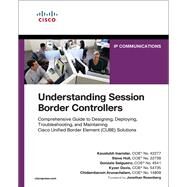Understanding Session Border Controllers Comprehensive Guide to Deploying and Maintaining Cisco Unified Border Element Solutions
, by Inamdar, Kaustubh; Holl, Steve; Salgueiro, Gonzalo; Davis, Kyzer; Arunachalam, Chidambaram- ISBN: 9781587144769 | 158714476X
- Cover: Paperback
- Copyright: 12/6/2018
Enterprise and service provider networks are increasingly adopting SIP as guiding protocol for session setup and tear down, and integrating Back to Back User Agent (B2BUA) and Session Border Controller (SBC) technology to enable this shift. Thousands of organizations have chosen the Cisco Unified Border Element (CUBE) as their B2BUA/SBC technology of choice. Understanding Session Border Controllers is the first comprehensive guide for network professionals and consultants who want to successfully master B2BUA/SBC theory, design, deployment, integration, operation, security, and troubleshooting. Using examples based on CUBE, the authors offer insights that will be valuable to technical professionals using any B2BUA/SBC solution, in any environment. Coverage includes:
- Key benefits of B2BUA/SBC, including topology abstraction, demarcation and security, media/protocol interworking, and interoperability with widely-diverse nodes
- Core concepts of SIP, H.323, DTMF, Fax/Modem over IP, Voice security, Media handling, and media/signal forking, and how they relate to B2BUA/SBC
- Efficient B2BUA deployment scenarios
- Securely migrating real-time communication over IP
- Using B2BUA to interoperate between asymmetric VoIP networks
- Establishing interoperability with call servers, proxies, fax servers, ITSPs, SIP registrar servers, redirect servers, and other devices







